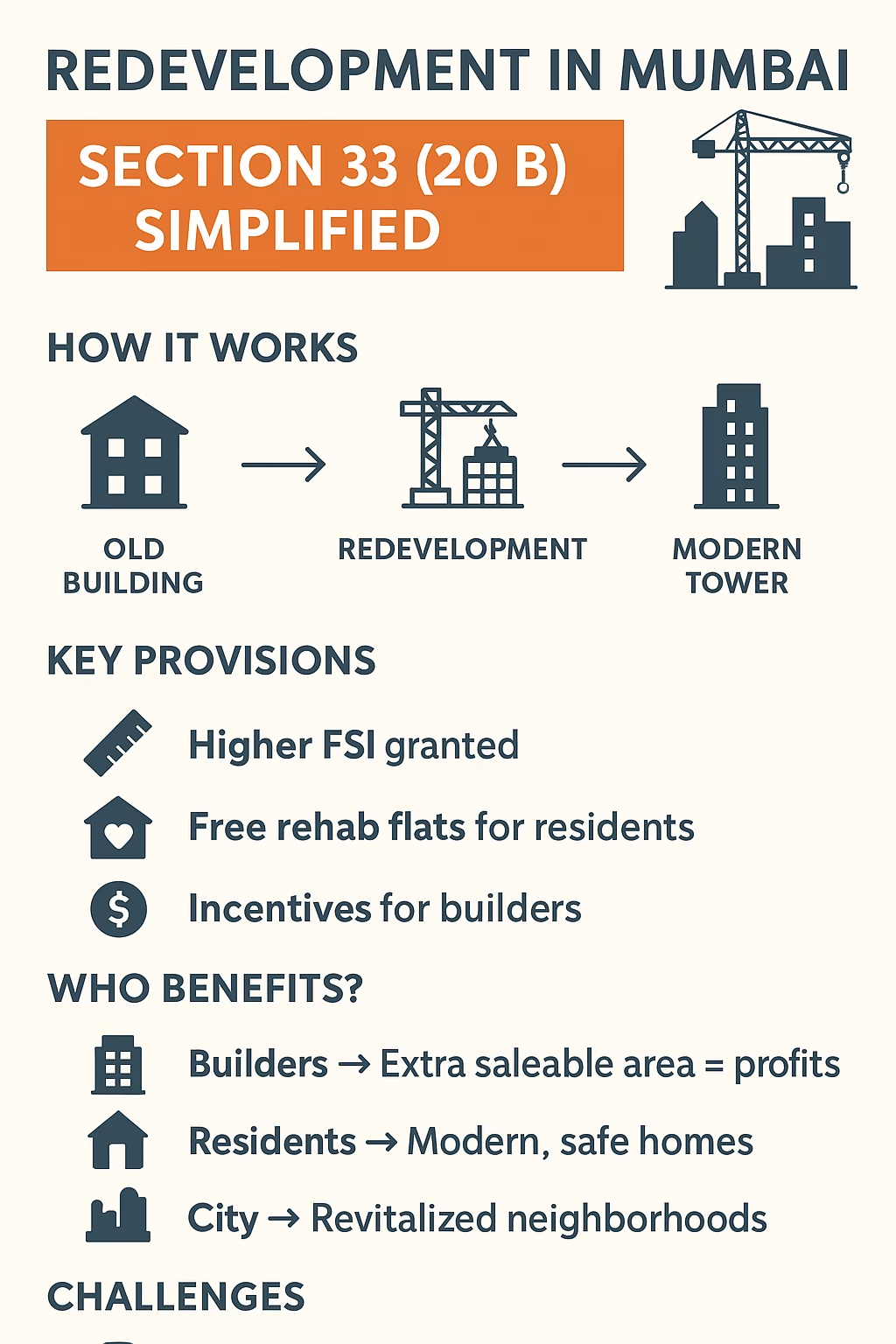BMC / MCGM: Section 33 (20 B) of DCPR 2034 — Key Technical Details
1. Eligibility & Applicability
-
- No minimum plot size requirement, making it broadly accessible.
-
- Minimum road width required is 12 meters.
-
- Plot area for FSI calculation excludes road setbacks and amenity spaces.
-
- Land Use Hierarchy: Includes amenities (LOS) between 15%–25% depending on plot size, and mandatory amenity space per Regulations 14(A)/14(B).
2. Mandatory Facilities & Amenities
-
- At least 25% of Basic FSI must be allocated for convenience shopping.
-
- Clubbing of plots is permitted within the same or adjoining ward or within a 5 km radius.
-
- Premium for clubbing: Charged at 40% of the difference in sale value of shifted Built-Up Area (BUA).
3. FSI Entitlements — By Location & Context
| Location | FSI Allowed | Sale/PAP Split |
|---|---|---|
| Island City (12 m road) | Up to 3.0 | 63% saleable / 37% PAP |
| Island City (18 m road) | Up to 4.0 | — |
| Suburbs / Extended (12 m road) | Up to 3.0 | 50% saleable / 50% PAP |
| Suburbs / Extended (18 m road) | Up to 4.0 | — |
4. Transfer of Development Rights (TDR) & Handover Conditions
-
- Developers can utilize TDR for unconsumed FSI, fostering flexibility.
-
- A key condition: 20% of TDR is released only after handing over the AH/R&R tenements to MCGM.
-
- Occupation Certificate (OC) for saleable areas is issued only after free handover of PAP housing.
5. Other Developer Benefits & Relaxations
-
- No premium is levied for fungible compensatory areas within PAP tenements.
6. Procedural Overview (Process Flow)
-
- Identify eligible plots (often cessed or aging structures).
-
- Developers prepare a detailed redevelopment proposal with AH/R&R components.
-
- Upon approval, PAP tenements must be handed over to MCGM free of cost.
-
- Subsequent to handover, developers receive saleable FSI, TDR, OCs, etc.
-
- Potential premium and relaxations are applied as per location and schemes.
Summary – Why This Matters
-
- Comprehensive Framework: Section 33 (20 B) balances redevelopment efficiency, PAP rehabilitation, and developer profitability—all under a regulated structure.
-
- Location-Sensitive Incentives: Higher FSI coupled with different sale/PAP ratios depending on road width and area (Island vs. Suburban).
-
- Accountability Ensured: Developers must deliver rehabilitation units upfront to unlock full benefits—ensuring transparency and execution.
-
- Flexibility Meets Oversight: Plot clubbing and TDR offer developmental flexibility; relaxations ease project constraints—with checks via premiums and documentation.
 Disclaimer
Disclaimer
The information provided in this article is for educational and informational purposes only. Kindly consult your architect, legal advisor, or relevant professional before making any decisions related to redevelopment or real estate. This content should not be treated as professional advice or a substitute for regulatory consultation.

